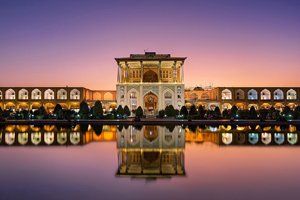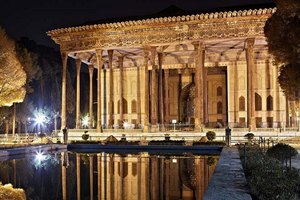Naqshe-e Jahan Square, also known as Imam Square is a historical complex in the heart of ancient Isfahan. The square was constructed by Shah Abbas I at the beginning of 17th century. This square is surrounded by historical monuments on all sides, and all these monuments are linked together by two-story arcades. The monuments that surround the square include Ali Qapu Palace, Shah Mosque, Sheikh Lotfollah Mosque and Qeysarie Gate. At first, there was a vast garden called Naqshe-e Jahan (image of the world) long before Isfahan had become the capital of Persia during Safavid reign. The square was one of the largest squares of the world in 17th century, and Sir John Chardin (a French jeweler and traveler) described it as the most beautiful square in the world. During Shah Abbas the Great and his successors, Naqshe-e Jahan Square was the place for royal celebrations, army parades, and other performances. Beside these, on normal days, the square was a place for shopping. The square was registered as national heritage in 1934 and also, as one of the UNESCO World Heritage sites in May 1978. Many travelers and tourists who described Isfahan in recent times, spoke about the magnitude of Naqshe-e Jahan Square and its important role during Safavid dynasty.

There are eleven bridges over Zayanderud River in half of the world, Isfahan. The longest one is named Allahverdi Khan Bridge. This bridge is popular as Si-o-Se Pol Bridge among local people. This scenic bridge was built during Shah Abbas, the ruler of Safavid dynasty, upon the order of Allahverdi Khan. He was the chancellor of the king. Si-o-Se Pol Bridge was made of thirty three spans and was used as both dam and bridge. It is believed that the wetter the bridge gets, the stronger it would be. Si-o-Se Pol Bridge is a nice example depicting the beautiful architectural style of Iran at that era. According to many travelers, this bridge is a masterpiece of architecture which worth taking a trip to Iran to visit. In addition to this bridge, Isfahan hosts many other attractions to provide avid tourists with an unforgettable trip.
Chehel Sotoun Palace that has been named as one of the most blessed buildings of the world left from Safavid dynasty, is located in the middle of a beautiful garden next to a pool in Isfahan. As the result of excavations, two inscriptions were found, showing that the construction of the palace started at the time of Shah Abbas I and ended during the rule of Shah Abbas II. The palace is 2120 square meters big. Chehel Sotoun Garden has three entrances that the old one opens to the east side. When entering the garden through the main entrance, after a short distance, there will be a large pool in the front and then the mansion itself. Chehel Sotoun is an example of royal garden from Safavid dynasty. The architecture of the palace is an integration of foreign and Iranian arts, and features a main porch. The porch itself includes two parts, one fixed on 18 wooden columns along with four columns in the middle that are installed on four stone lions. The other part is slightly higher and forms the entrance and is referred to as Mirror Hall. This part is situated on two columns and decorated with thousands of glittering mirrors. The ceiling is made of wooden frames in various geometric shapes. The central hall was allocated to foreign guests, and contains paintings that represent the historical events of different periods. Paintings in the central hall, some of which belong to Qajar era, depict Shah Abbas I and II hosting Shah Tahmasp I and Humayun (the second emperor of the Mughal Empire), as well as the war of Shah Ismail I against Uzbakan. Right now, Chehel Sotoun Palaces is a garden museum, and the central hall displays some artworks of different periods. It is one of the most spectacular and historic places in Isfahan, visited by many foreign tourists and guests.
Formerly known as Shah Mosque in Isfahan, Imam Mosque, located on the south side of Naghsh-e Jahan Square, is an extraordinary unique structure of the world. The construction of the mosque started during Shah Abbas I and is considered as a great example of Islamic architecture. Its reputation mainly relates to delicate tile works, stunning architecture, charming dome and unique stone carvings. The main entrance which is located on the west side of the mosque addresses a big square as the central square of Isfahan, and there also is a fountain just at the beginning of the entrance. The arch of the great entrance is lined with colorful Muqarnas. There are two tall minarets on both sides of the entrance, and two-story shops around the main square. Domed side halls on the east side of the mosque are connected to the main courtyard, where there are two Madrasas (school). The double shell dome located in the north part of the mosque and the exterior part are covered with the most beautiful blue and gold tiles. There are also two more minarets on both sides of the dome as tall as 48 meters. There are some entrances which are connected to other parts of the city. Imam Mosque was registered as one of the national heritages in 1931.
Menar Jonban is a historical monument in Isfahan which is the burial place of Amu Abdollah Soqlabi, who was a mystic in the 14th century. Some minarets in Iran have the ability to shake which are called Monar Jonban. There are some Menar Jonban in Iran and among them, we can refer to one in Isfahan, and another one in Ardakan. The Iwan located in Menar jonban in Isfahan is as high as 10 meters and each of the two minarets is about 7.5 meters. The roof and the minarets are accessible through a small gate and spiral stairs. But, what makes this building famous is that the minarets can shake. Once you shake one of the minarets, the other minarets along with whole building start shaking. The Iwan dates back to Ilkhani dynasty, but the architectural style of the minarets show that they were made in late Safavid era. The reason has long been questioned by scientists, and many still believe that there is no logical reason. The building is decorated with turquoise tiles in form of stars and other figures. There are some signs and objects in the building that one can notice the vibration while looking at these signs.
Located on the west side of Naqshe-e Jahan Square, Ali Qapu Palace in Isfahan that was famous as the tallest building in the capital of Safavid dynasty for centuries, attracts the attention of every visitor to its eye-catching designs and miniature art. The palace has five entrances and the most important one is called Ali Qapu. Other doors are Chahar Howz in the north, Shahi Entrance overlooking the city gate in the west, Harem (the entrance for the women), and finally the so called Matbakh (the Kitchen) entrance. The construction of this mansion has been completed in 5 architectural stages during the successors of Shah Abbas I, especially Shah Abbas II and Shah Suleiman ad it lasted for 70 to100 years. Even the existed inscriptions with nasta'liq script remained from Shah Sultan Hussein period indicate that the decoration of the third floor was added or restored during the time of this last Safavid king. Ali Qapu Palace is a three-story building and each floor is divided into two other ones, so there are actually six floors. Due to the fact that the roof overlooks the whole city, it is considered as one floor, and that’s why it is believed that Ali Qapu is a seven-story building. One interesting thing about this palace is that the number of the stories look different from exterior view, for instance, the palace seems to have two floors from the eastern side, five floors from the western side, and seven floors through the stairs. The mansion features an Iwan with beautiful column and a small pool in the middle. After passing through the entrance, you will see an elegant dome above your head. Each floor has its own unique decorations. Delicate paintings of flowers, plants, animals, geometric shapes and poultry cover all over the interior walls. In the last four years, due to the destructive danger that threatened Ali Qapu Palace, repairs were carried out by Iranian and foreign specialists.
Vank Cathedral, also known as Amenaperkic, is a church located in Jolfa district of Isfahan. This church is one of the historical Armenians’ churches and was constructed at the time of Shah Abbas II. Vank means Congregational cathedral in Armenian language. Armenians immigrated to Isfahan after the Great Migration, in 1605, upon the order of Shah Abbas II. As they arrived, they began to build a place to live and due to their religious beliefs, building churches was the first step. Vank Cathedral is considered as the largest and most beautiful church in Jolfa. All interior parts of the building are covered with oil paintings and golden decorations displaying images of Christ's life, influenced by Italian paintings. The belfry which is located across from the main entrance, dates back to Shah Sultan Husayn Safavi. The praying room having a parallelogram shape, consists of two parts, the first part is Shabestan, an underground space in traditional mosques, and the second part is under the dome, a place for performing religious anthem and ceremonies. The walls of praying room are covered with delicate multi-colored tiles. In the upper parts of the wall, beautiful pictures, inspired by the holy book, are painted. There are many pictures all around the dome depicting the story of creating Adam and Eve. The altar depicts many images such as an image of Christ as well. The exterior design of the dome is simple without tiled ornament, and it’s just brick work. On a corner of the courtyard, there is a huge elegant bell situated on four stone columns while on another corner, and in front of the bell tower, there is a long column, made in memorial of 1.5 million Armenians who were massacred in 1915. The bell tower consists of three floors and it is located above the entrance. On the second floor of the tower, there is a massive watch weighting over 300 kg. The Vank cathedral has various sections, such as a museum and a library. The Museum of the Church was built in 1905 AD, and exhibits 700 manuscripts, carved stones, paintings by European painters who donated them to the church along with potteries and wooden works such as furniture, watches, candlesticks, and woodcarving boards.






